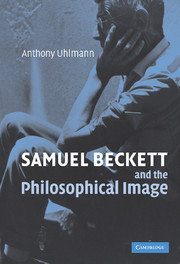Book contents
- Frontmatter
- Contents
- Acknowledgements
- Introduction
- 1 Representation and presentation: Deleuze, Bergson, Peirce and ‘the image’
- 2 Beckett's aesthetic writings and ‘the image’
- 3 Relation and nonrelation
- 4 The philosophical imaginary
- 5 Cogito nescio
- 6 Beckett, Berkeley, Bergson, Film: the intuition image
- 7 The Ancient Stoics and the ontological image
- Conclusion
- Notes
- Works cited
- Index
6 - Beckett, Berkeley, Bergson, Film: the intuition image
Published online by Cambridge University Press: 22 September 2009
- Frontmatter
- Contents
- Acknowledgements
- Introduction
- 1 Representation and presentation: Deleuze, Bergson, Peirce and ‘the image’
- 2 Beckett's aesthetic writings and ‘the image’
- 3 Relation and nonrelation
- 4 The philosophical imaginary
- 5 Cogito nescio
- 6 Beckett, Berkeley, Bergson, Film: the intuition image
- 7 The Ancient Stoics and the ontological image
- Conclusion
- Notes
- Works cited
- Index
Summary
IMAGES, PHILOSOPHY, LITERATURE
As touched upon in the discussion of Le Doeuff, the supposed conflict between the knowledge (considered dubious, unworthy) offered by the senses and that offered by the light of reason alone (which alone might lead us to the truth) has long drawn a distinction between images and ideas or concepts. We see this, of course, in the celebrated image of the cave in Plato's Republic: the truth, the Idea, is like the light of the sun, and is only open to us through reason, whereas we are habitually caught up with the play of images which are illusory and misleading, like the shadows on the wall of the cave. Perhaps still more famously Descartes opposed the light of reason (which delivers us clear and distinct ideas or concepts) to the confused impressions we are given by the images offered to us by the senses.
Yet, if one looks slightly closer, it becomes apparent that the image and the idea are also closely linked. Nietzsche, in the Birth of Tragedy, points out that Plato not only attacks art and artists, casting them out of his Republic, but also provides a life-raft for art with his Dialogues. So too Stephen Gaukroger has brought to light Descartes's interest in rhetoric – the vividness of images – as a way of expressing truths.
- Type
- Chapter
- Information
- Samuel Beckett and the Philosophical Image , pp. 114 - 128Publisher: Cambridge University PressPrint publication year: 2006



